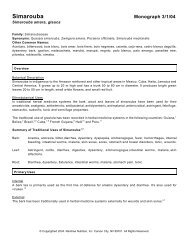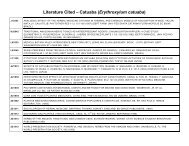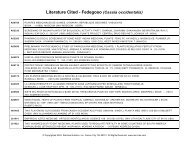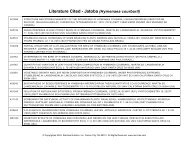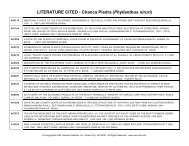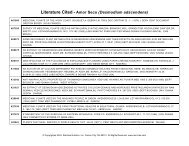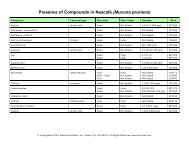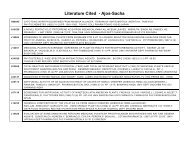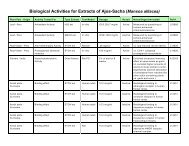Organ Specific Guide - Raintree Nutrition, Inc
Organ Specific Guide - Raintree Nutrition, Inc
Organ Specific Guide - Raintree Nutrition, Inc
Create successful ePaper yourself
Turn your PDF publications into a flip-book with our unique Google optimized e-Paper software.
AMAZON JOINT-MUSCLE SUPPORT<br />
Description: A powerful formula of rainforest botanicals which have been used indigenously in the<br />
rainforest and South America for joints and muscles.<br />
Traditional uses by organ or system: Musculoskeletal: For arthritis, muscle and joint injuries, and<br />
muscle and joint pain and inflammation.<br />
Ingredients: A proprietary blend of cat’s claw (Uncaria tomentosa), chuchuhuasi (Maytenus krukovii),<br />
amor seco (Desmodium adscendens), tayuya (Cayaponia tayuya), picão preto (Bidens pilosa), iporuru<br />
(Alchornea castaneifolia), sarsaparilla (Smilax officinalis) and guaco (Mikania guaco).<br />
Suggested Use: Take 2-3 capsules (depending on body weight) every 4-6 hours or as needed.<br />
Contraindications:<br />
• Not to be used during pregnancy or while breast-feeding.<br />
• Several plants in this formula contain coumarin which has an anticoagulant effect. Individuals with<br />
bleeding disorders, such as hemophilia, should be not use this formula.<br />
• This product should not be used with medications intended to suppress the immune system.<br />
Drug Interactions: May potentiate anticoagulants such as coumadin. May reduce the effect of immune<br />
suppressive medications. May potentiate antihypertensive medications.<br />
Other Practitioner Observations and Possible Precautions:<br />
• Picão preto contains a small amount of naturally occurring caffeine. Those individuals sensitive or allergic<br />
to caffeine should avoid this formula.<br />
• Cat’s claw has been documented to have an antifertility effect. Those seeking to become pregnant or<br />
those undergoing treatment for infertility should probably avoid the use of this formula.<br />
Synopsis of research: (Please the online Tropical Plant Database for all cited research.)<br />
• Cat’s claw contains antioxidant chemicals (tannins, catechins and procyanidins) as well as plant sterols<br />
(beta-sitosterol, stigmasterol, and campesterol) which account for some of the plant's tested antiinflammatory<br />
properties. In addition, new and novel plant chemicals called quinovic acid glycosides were<br />
documented to be the most potent anti-inflammatory constituents of the plant. Human and animal studies<br />
indicate that cat's claw (and, especially, its glycosides) can inhibit inflammation from 46% up to 89% in<br />
various in vivo and in vitro tests.<br />
• Chuchuhuasi evidenced anti-inflammatory and analgesic activities in various studies with mice. One<br />
research group reported that these activities were at least partially linked to triterpenes and antioxidant<br />
chemicals isolated in the trunk bark. Another research group isolated another group of novel alkaloids<br />
in chuchuhuasi that may be responsible for its effectiveness in treating arthritis and rheumatism. A U.S.<br />
pharmaceutical company studying chuchuhuasi’s anti-inflammatory and anti-arthritic properties determined<br />
that these alkaloids can effectively inhibit enzyme production of protein kinase C.<br />
• Amor seco has been documented with antispasmodic and muscle relaxant actions in human and animal<br />
studies. It has also evidenced analgesic actions in animal testing.<br />
• Tayuya contains novel cucurbitacins chemicals with documented antioxidant, anti-inflammatory and<br />
analgesic properties.<br />
• Picão preto has shown in laboratory studies to mediate proinflammatory cytokines, inhibit prostaglandinsynthesis<br />
and inhibit cyclooxygenase (COX).<br />
• Iporuru was also able to inhibit COX-1 prostaglandin synthesis in laboratory studies. In other animal<br />
studies iporuru provided a marked anti-inflammatory effect against chemical-induced inflammation.<br />
• Sarsaparilla’s pharmacological properties and actions have been attributed to the steroids and saponins<br />
found in the plant. The saponins have been reported to facilitate the body's absorption of other drugs and<br />
phytochemicals, which accounts for its history of use in herbal formulas as an agent for bioavailability<br />
and to enhance the power and effect of other herbs.<br />
• Guaco has demonstrated analgesic and antispasmodic actions in animal studies, which has been<br />
attributed, in part, to the coumarin content of the plant (which can be as high as 10%).



